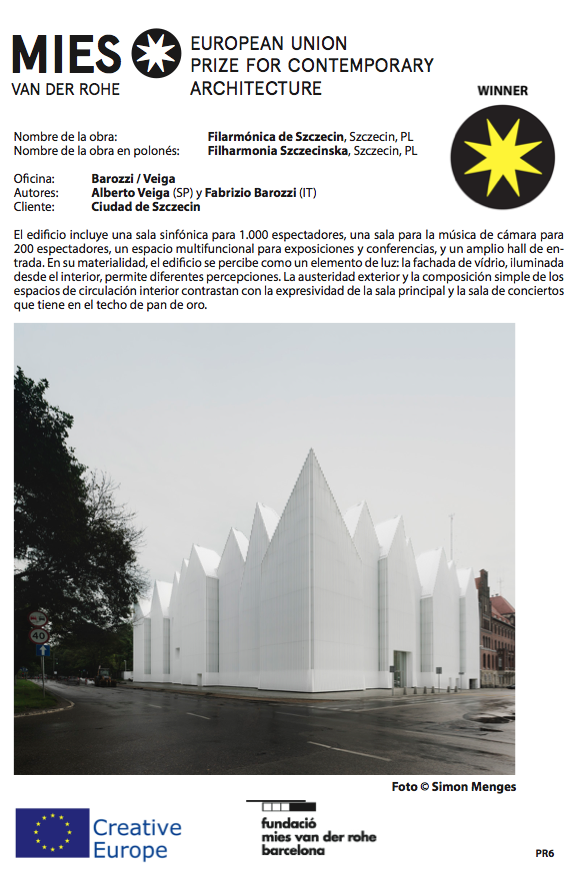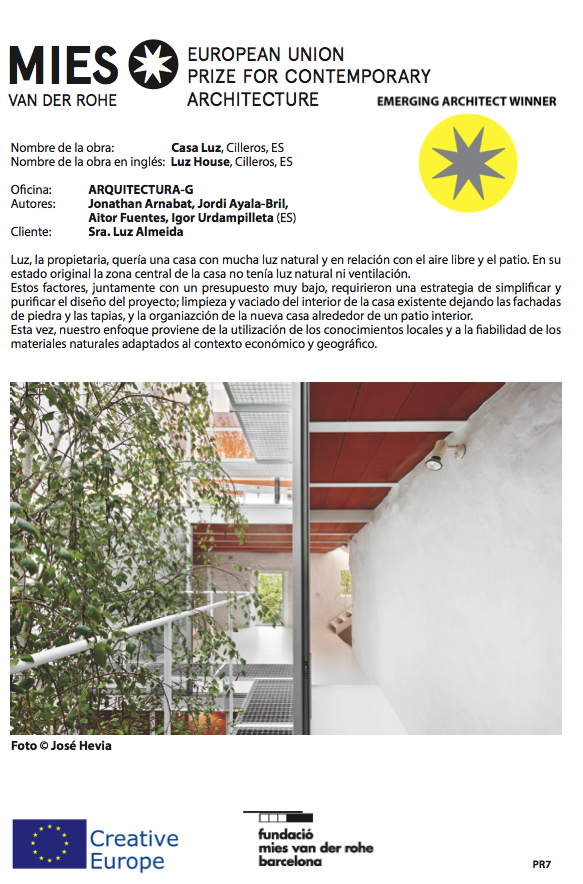


[nota oficial emtida por la Fundación Mies Van der Rohe]
La Filarmónica de Szczecin de Barozzi/Veiga (Alberto Veiga y Fabrizio Barozzi) con la colaboración de Studio A4, GANADOR DEL PREMIO DE ARQUITECTURA CONTEMPORÁNEA DE LA UNIÓN EUROPEA-PREMIO MIES VAN DER ROHE 2015
El estudio catalán ARQUITECTURA-G, galardonado con el Premio Arquitecto Emergente
Barcelona, 8 de mayo de 2015. La Filarmónica de Szczecin es el ganador del Premio de Arquitectura Contemporánea de la Unión Europea – Premio Mies van der Rohe 2015, que la Comisión Europea y la Fundació Mies van der Rohe han anunciado hoy.
El Premio al Arquitecto Emergente ha sido para el estudio catalán ARQUITECTURA-G, por la obra Casa Luz, una vivienda unifamiliar situada en la localidad extremeña de Cilleros fruto de una renovación completa de una casa ya existente pero en condiciones muy deterioradas.
La ceremonia de entrega ha tenido lugar hoy, 8 de mayo en el Pabellón Mies van der Rohe de Barcelona
Los premiados han sido elegidos entre 420 obras de 36 países europeos. De éstas, se seleccionaron cinco finalistas:
Museo de Arte de Ravensburg (Lederer Ragnarsdóttir Oei),
Museo Marítimo de Dinamarca en HelsingØr (BIG – Bjarke Ingels Group),
Bodega Antinori (Italia – estudio Archea Associati),
Filarmónica de Szczecin, Polonia (Barozzi/Veiga)
y el Centro de Estudiantes Saw Swee Hock LSE en Londres (O’Donnell + Tuomey)
Jens Nymand Christensen, director general adjunto de Educación y Cultura de la Comisión Europea, y Antoni Vives, teniente de alcalde de Barcelona y Presidente de la Fundació Mies van der Rohe, han concedido a los ganadores los premios de 60.000€ (el premio principal) y 20.000€ (arquitecto emergente). Los ganadores también han recibido una escultura del artista catalán Xavier Corberó, y los finalistas y los clientes han recibido una medalla que premia su trabajo e implicación en la construcción de gran calidad del territorio Europeo.
Diseñado por Barozzi/Veiga (Alberto Veiga y Fabrizio Barozzi) con la colaboración de Studio A4, la Filarmónica de Szczecin alberga una sala sinfónica para 1.000 espectadores, una sala para música de cámara para 200 espectadores, un espacio multifuncional para exposiciones y conferencias, y un amplio hall de entrada. En su materialidad, el edificio se percibe como un elemento de luz: la fachada de vidrio, iluminada desde el interior, permite diferentes percepciones. La austeridad exterior y la sencilla composición de los espacios de circulación interior contrastan con la expresividad de la sala principal y la sala de conciertos cubierta de pan de oro.
Cino Zucchi, presidente del jurado ha valorado las dos obras ganadoras:
Luz House, Cilleros, Caceres, Spain, ARQUITECTURA–G
The jury felt that the designers understood well and solved brilliantly the constructive and economic constraints of the project, a new structure inserted in the stone party walls of an existing town house. A direct dialogue with the client and the clear strategy to build the program around a new courtyard allowed the simple yet effective construction of this single house. The architects used the existing stone façades and adobe party walls to achieve very high spatial qualities with very cheap construction materials.
The Jury appreciated the simplicity and clarity of the spaces, their high environmental quality and the colour palette resulting from the terracotta tiles left unfinished, showing that a good architecture does not need to be expensive or spectacular
In the evaluation process of an important award like the Mies van der Rohe one, the jury is called to observe and judge the architectural quality of projects, which are very different in their program, context, scale, and cultural milieu.
Today Europe is confronting its rich and varied heritage with the great changes the environments and societies are going through. Apart from the great differences still existing between its regions, we share the idea that the act of design, beside its necessary response to its functional and economic conditions, should enhance the comfort, the degree of social interaction, and the cultural life of its users.
The five finalists and the winner of the 2015 European Union Prize for Contemporary Architecture – Mies van der Rohe Award have been chosen because of their capacity of doing a number of things: to read and transform their context, which is often very complex and precious; to generate a symbiosis between the new and the existing, and between their function and the public realm; to transformed physical, economic or technical constraints into resources; to create a series of spaces appreciated by the users, shaping a welcoming meeting place; and finally, to be able to constitute a bold architectural statement, enabling a dialogue between the evolution of a discipline and the parallel evolution of the values and need of society.
The winning project, the Philharmonic Hall Szczecin, Szczecin, Poland, Barozzi/Veiga (Studio A4 collaborator) is the winning entry of an international open competition for the design of a new complex on the site of the old one. Public expectations charged the program not only with a number of integrated functions – a large hall for symphonic music and a smaller one for chamber music, a grand foyer with upper level exposition spaces – but also with a new symbolic role. The series of pitched gables which crowns the rectangular complex of the new building dialogues well with the silhouette of the nearby Castle. The main symphony hall one is clad by triangular wooden acoustic panels gilded with gold leaf. A large hall with the cafeteria and two
grand open stairs take the role of a new covered square in the cold seasons, while multi-functional rooms wrap around the concert halls, offering new chances for cultural and leisure events.
This winning project finds a convincing formal and spatial strategy for a city which strives for a better future in a fast changing economy and social patterns, delivering a dignity to urban life and the same time enhancing the city’s specific historical identity with a contemporary “monument”.
El Premio de Arquitectura Contemporánea de la Unión Europea – Premio Mies van der Rohe destaca la contribución de los arquitectos europeos al desarrollo de nuevas ideas y tecnologías en el ámbito urbano contemporáneo. Presentado en 1987 y cofinanciado por el Programa Cultural de la UE y la Fundación Mies van der Rohe, es el Premio más prestigioso de la arquitectura europea. Se otorga cada dos años a obras que han sido acabadas durante los dos años anteriores. Las obras nominadas al Premio son propuestas por expertos independientes, así como también por miembros de las asociaciones del Consejo de arquitectos de Europa, de las asociaciones nacionales de arquitectos y por el Comité Asesor.
El Premio adopta el nombre de Ludwig Mies van der Rohe, por ser considerado uno de los pioneros de la arquitectura moderna del siglo XX. Sus obras más emblemáticas incluyen el Pabellón Alemán de la Exposición Internacional celebrada en Barcelona en el 1929, la Villa Tugendhat en Brno, República Checa, el edificio Seagram en Nueva York y la National Gallery en Berlín.
Al tiempo que reconoce la excelencia, el Premio de Arquitectura Contemporánea de la Unión Europea – Premio Mies van der Rohe anima a los arquitectos a trabajar fuera de les fronteras nacionales y contribuir a construir una Europa más fuerte y más creativa, en línea con los objetivos de la Estrategia de Europa 2020.
Los miembros del jurado de la edición 2015 son: Cino Zucchi, presidente del jurado, Director, Cino Zucchi Architetti, Milán; Margarita Jover, directora de Alday Jover Architecture and Landscape, Charlottesville y Barcelona; Lene Tranberg, Directora, Lundgaard & Tranberg, Copenhaguen; Peter L. Wilson, Director, Bolles + Wilson, Münster; Xiangning Li, vicedecano College of Architecture & Urban Planning, Tongji University, Shanghai; Tony Chapman, Jefe de los Premios RIBA, Londres; y Hansjörg Mölk, CEO MPreis, Völs, Tirol.
Sin derecho a voto, Giovanna Carnevali, directora de la Fundació Mies van der Rohe, ha ejercido de Secretaria e Ivan Blasi ha coordinado el Premio.
Contacts:
For Fundació Mies van der Rohe
Press: Mercedes Soler-Lluró, Gemma Pascual / ICE On-line Press: Miriam Giordano, Silvia Pujalte / Labóh Mail: press@miesbcn.com
Tel.: +34 932151011
To find out more:
http://www.miesarch.com http://ec.europa.eu/culture
Social Media:
https://twitter.com/EUMiesAward https://twitter.com/europe_creative http://www.facebook.com/EuMiesAward https://www.facebook.com/CreativeEuropeEU http://instagram.com/eumiesaward/
#eumiesaward2015 #5finalists
FB: @EuMiesAward TW: @EuMiesAward IG: @EuMiesAward
Agentes: Fabrizio Barozzi
Agentes: Fundación Mies van der Rohe
Agentes: ARQUITECTURA-G





